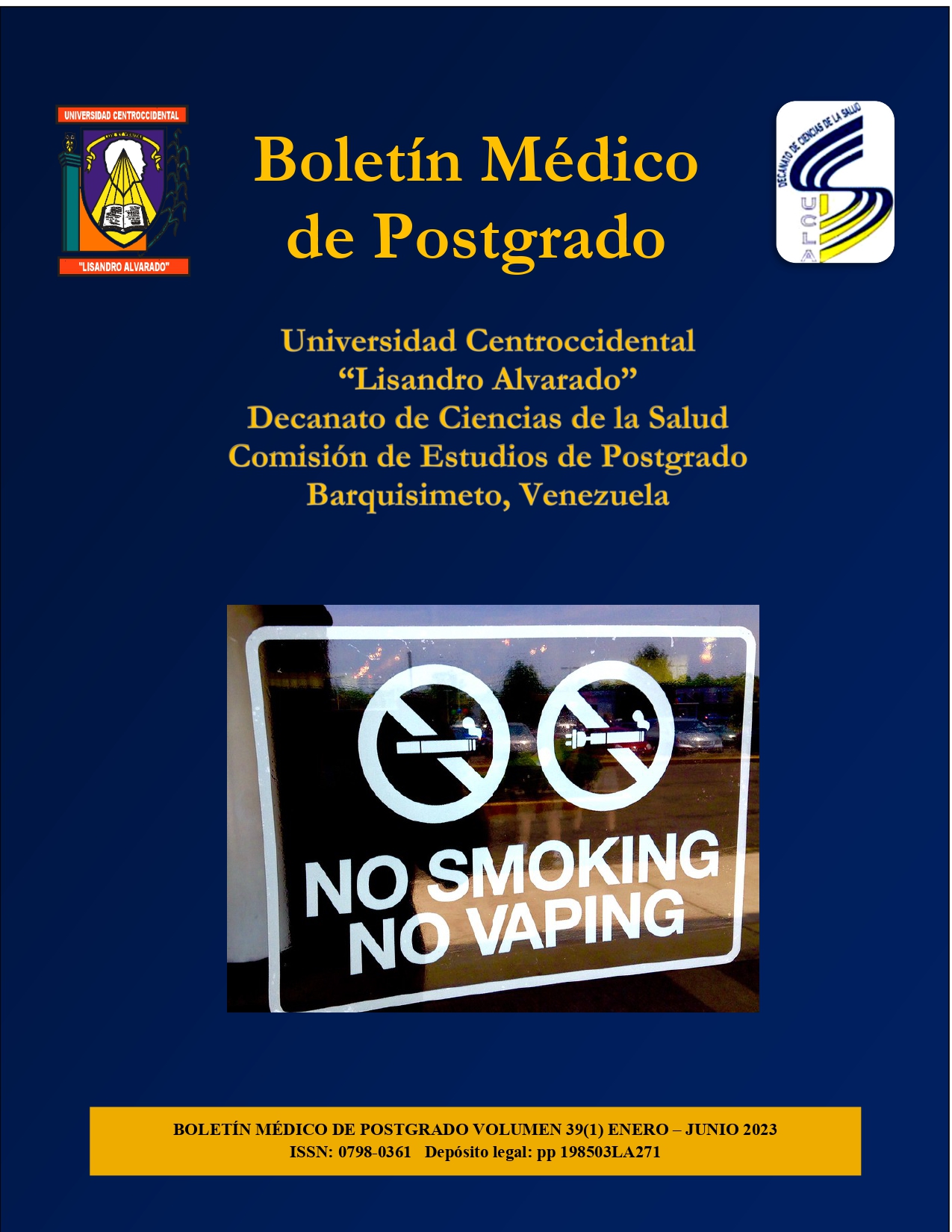Microcephaly in neonates of mothers with prenatal exposure to Zika virus. A systematic review
Keywords:
Zika virus, microcephaly, newborn, congenital abnormalities, systematic reviewAbstract
A research was carried out with the aim of identifying the presence of microcephaly in neonates of mothers with prenatal exposure to Zika virus. The bibliographic search was carried out within the period November-December 2021, in full text and, English and Spanish languages, in Medline, LILAC, BVS, Cibertedis, Thesaurus, PubMed, Scielo, Elsevier, Science Direct, Academic Google and ResearchGate databases. Data were extracted using a data extraction form developed by the author that followed the recommendations described in the Cochrane Handbook of Systematic Reviews of Interventions (version 5.1.0). Information on the bibliometric characteristics of the articles, methodology (study design, sample year, means of publication) and conclusions was extracted. From this review it can be concluded that in the population studied microcephaly is most likely a result of congenital Zika virus infection classified as a neurotropic and teratogenic virus, however, more research is needed to better understand the possible implications of these findings.
Downloads
References
Zoghbi N, López Á. La llegada del virus Zika a Venezuela y su posible huella en la salud materna-infantil. Una discusión impostergable. Comunidad y Salud 2016; 14(1): 67-73
Organización Panamericana de la Salud/Organización Mundial de la Salud OPS OMS. (2016a). Actualización Epidemiológica [Documento en línea]. Disponible: http://www.paho.org/hq/index.php?option=com_content&view=article&id=11599%3Aregional-zika-epidemiological-update-americas&catid=8424%3Acontents&Itemid=41691&lang=es. [Consulta: 2018, abril 4]
Organización Panamericana de la Salud/Organización Mundial de la Salud. OPS/OMS (2015d). Aumento de microcefalia congénita y otros síntomas del sistema nervioso central - 10 de febrero de 2016. [Documento en línea]. Disponible: http://www.paho.org/hq/index.php?option=com_content&view=article&id=11675&Itemid=41711&lang=eshttps://www.paho.org/hq/index.php?option=com_docman&task=doc_view&Itemid=270&gid=33662&lang=es. [Consulta: 2018, abril 1]
Sociedad Española de Infectología Pediátrica (SEIP) y Sociedad Española de Neonatología (SENeo). (2016). Protocolo de actuación pediátrica y neonatal ante el brote de enfermedad por virus Zika en América. [Documento en línea]. Disponible: http://www.aeped.es/sites/default/files/documentos/protocolo-pediatrico-neonatal-zika.pdf. [Consulta: 2018, abril 4]
Ministerio de Salud Pública (2016). Dirección Nacional de Vigilancia Epidemiológica, gaceta epidemiológica semanal no. 10. [Documento en línea]. Disponible: http://www.salud.gob.ec/wp-content/uploads/2013/02/GACETA-GENERAL-SE10.pdf. [Consulta: 2018, Abril 1]
Organización Panamericana de la Salud/Organización Mundial de la Salud. OPS/OMS (2016c). Zika-Actualización Epidemiológica. [Documento en línea]. Disponible: https://www.paho.org/hq/index.php?option=com_docman&task=doc_view&Itemid=270&gid=33662&lang=es. [Consulta: 2018, abril 1]
Jorge M. (2016). El peligroso zumbido del aedes. La amenaza a las mujeres embarazadas. [Documento en línea]. Disponible: http://gmiradasmultiples.blogspot.com/2016/02/venezuela-el-peligroso-zumbido-del.html. [Consulta: 2018, marzo 24]
Lozada M. (2016). Ocho bebés con microcefalia reportados en la Maternidad Concepción Palacios este año. [Documento en línea]. Disponible: http://efectococuyo.com/principales/ocho-bebes-con-microcefalia-han-pasado-por-la-maternidad-concepcion-palacios-este-ano. [Consulta: 2018, marzo 28]
Torres J. (2016). Confirman primer caso de microcefalia y muerte fetal en Monagas [Documento en línea]. Disponible: https://prensalternativa.com.ve/2016/03/03/confirmaron-primer-caso-de-microcefalia-y-muerte-fetal-en-monagas/ [Consulta:2018. Abril 4]
Organización Panamericana de la Salud/Organización Mundial de la Salud. OPS/OMS (2016b). Actualización Epidemiológica: Síndrome neurológico, anomalías congénitas, e infección por virus Zika. [Documento en línea]. Disponible: http://www.paho.org/hq/index.php?option=com_docman&task=doc_view&Itemid=270&gid=32876&lang=es. [Consulta: 2018, abril 4]
Barreto T, Cunha L, Arraes R, de Barros D, Ramos U, Lopes A, et al. Association between Zika virus infection and microcephaly in Brazil, January to May, 2016: preliminary report of a case-control study. The Lancet Infectious Disease 2016; 16(12): P1356-1363
Nascimento J. Evaluación del desarrollo neuropsicomotor de niños con microcefalia potencialmente asociada con el virus del Zika. Repositorio Institucional de la Universidad Federal de Sergipe, Brasil, 2019
Ventura C, Maia M, Vasco Bravo F, Gois A, Belfort R. Zika virus in Brazil and macular atrophy in a child with microcephaly. Lancet 2016; 387(10015): 228
Faizan I, Abdullah M, Ali S, Naqvi I, Ahmen A, Parveen S. Zika Virus-Induced Microcephaly and Its Possible Molecular Mechanism. Intervirology 2016; 59(3): 152-158
Chavali P, Stojic L, Meredith L, Joseph N, Nahorski M, Sanford T, et al. Neurodevelopmental protein Musashi 1 interacts with the Zika genome and promotes viral replication. Science 2017; 357(6346): 83-88
Schwartz D. The Origins and Emergence of Zika Virus, the Newest TORCH Infection: What's Old Is New Again. Arch Pathol Lab Med 2017; 141(1): 68-72
Alvarado M, Schwart D. Zika Virus Infection in Pregnancy, Microcephaly, and Maternal and Fetal Health: What We Think, What We Know, and What We Think We Know. Arch Pathol Lab Med 2017; 141(1): 26-32
Ticconi C, Pietropolli A, Rezza G. Zika virus infection and pregnancy: what we do and do not know. Patog Glob Health 2016; 1–7
Honein M, Dawson A, Petersen E, Jones A, Lee E, Yazdy M, et al. Birth Defects Among Fetuses and Infants of US Women With Evidence of Possible Zika Virus Infection During Pregnancy. JAMA 2017; 317(1): 59-68
Reynolds M, Jones A, Petersen E, Lee E, Rice M, Bingman A, et al. Vital Signs: Update on Zika Virus-Associated Birth Defects and Evaluation of All U.S. Infants with Congenital Zika Virus Exposure - U.S. Zika Pregnancy Registry, 2016. MMWR Morb Mortal Wkly Rep 2017; 66(13): 366-373
Walker C, Little M, Roby J, Armistead B, Gale M, Rajagopal L, et al. Zika Virus and the Non-Microcephalic Fetus: Why We Should Still Worry. Am J Obstet Gynecol 2019; 220(1): 45-56
Castanha P, Souza W, Braga C, Velho T, Ximenes R, Albuquerque M, et al. Perinatal analyses of Zika- and dengue virus-specific neutralizing antibodies: A microcephaly case-control study in an area of high dengue endemicity in Brazil. PLoS Negl Trop Dis 2019; 13 (3): e0007246
Castro D. Asociación entre el virus del Zika y la microcefalia. Una revisión sistemática Universidad Surcolombiana 2017
Cavalheiro S, López A, Serra S, Da Cunha A, Devanir M, Moron A, et al. Microcephaly and Zika virus: neonatal neuroradiological aspects. Childs Nerv Syst 2016; 32: 1057–1060
Published
How to Cite
Issue
Section

This work is licensed under a Creative Commons Attribution-NonCommercial-ShareAlike 4.0 International License.
Las opiniones expresadas por los autores no necesariamente reflejan la postura del editor de la publicación ni de la UCLA. Se autoriza la reproducción total o parcial de los textos aquí publicados, siempre y cuando se cite la fuente completa y la dirección electrónica de esta revista. Los autores(as) tienen el derecho de utilizar sus artículos para cualquier propósito siempre y cuando se realice sin fines de lucro. Los autores(as) pueden publicar en internet o cualquier otro medio la versión final aprobada de su trabajo, luego que esta ha sido publicada en esta revista.



